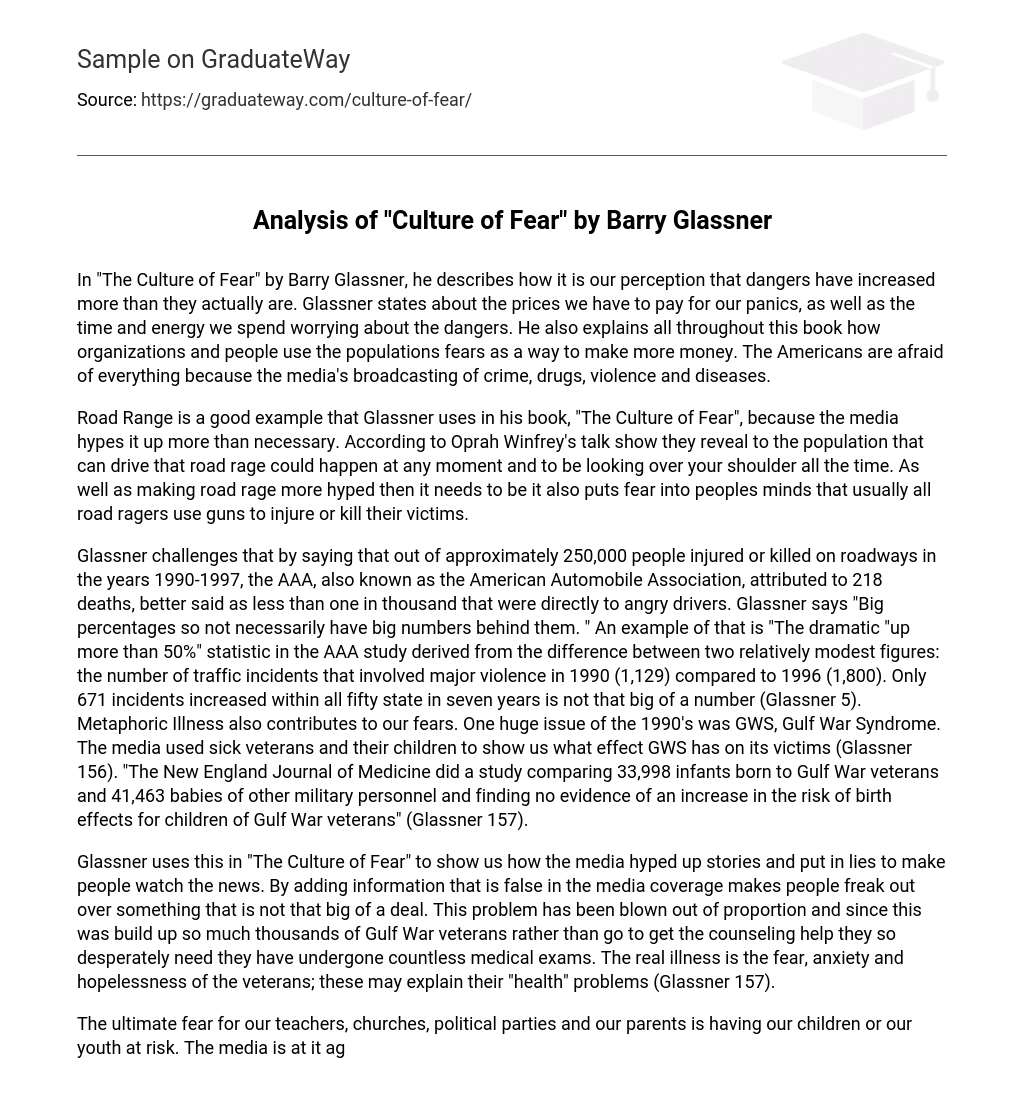Barry Glassner’s “The Culture of Fear” explores the disparity between our perception of increased dangers and the actual level of threat. Glassner delves into the consequences and costs of our panics, as well as the time and energy we expend worrying about these perceived dangers. Throughout the book, Glassner also exposes how organizations and individuals exploit the fears of the populace to generate profit. The media’s incessant coverage of crime, drugs, violence, and diseases instills a pervasive fear among Americans regarding almost everything.
In his book, “The Culture of Fear”, Glassner uses Road Range as a prime example to illustrate how the media sensationalizes it unnecessarily. On Oprah Winfrey’s talk show, it was conveyed to the public that road rage could occur at any given moment, instilling a constant sense of apprehension. In addition to exaggerating the seriousness of road rage, the media also implants the idea that all road ragers typically employ firearms to harm or even fatally injure their victims.
Glassner challenges the idea that angry drivers cause a significant number of deaths on roadways. He points out that, between 1990 and 1997, the American Automobile Association (AAA) only attributed 218 deaths directly to angry drivers out of approximately 250,000 people injured or killed. Glassner argues that large percentages often have small numbers behind them. He gives an example where the AAA study claimed a more than 50% increase, but this was based on just a difference of 671 incidents over seven years across all fifty states. Additionally, Glassner discusses how metaphoric illnesses can influence our fears, using Gulf War Syndrome (GWS) as an example from the 1990s. The media portrayed sick veterans and their children as examples of GWS effects. However, Glassner references a study in The New England Journal of Medicine which found no evidence of an increased risk of birth defects for children of Gulf War veterans compared to other military personnel.
Glassner’s book “The Culture of Fear” suggests that the media uses exaggeration and falsehoods to gain viewership, leading people to become unnecessarily alarmed over minor issues. Consequently, Gulf War veterans have been forced to undergo multiple medical examinations instead of receiving the vital counseling they need urgently. The main concern here is the fear, anxiety, and despair experienced by these veterans, which may be responsible for their reported “health” problems (Glassner 157).
Our teachers, churches, political parties, and parents all share a common fear – the safety of our children and youth. Once again, the media is amplifying stories about our young generation, ranging from incidents like school shootings and missing children to teenage gambling. By continuously highlighting these events, the media aims to instill a belief that there is an alarming increase in youth violence. In his book, Glassner challenges us to reflect on the accuracy of these constant television broadcasts and whether they contain false information intended to perpetuate our fear.
The unpredictability of both children and adults raises questions about where our interest lies. Glassner quotes Bob Dole, who asserts that the focus of the juvenile justice system should be shifted from rehabilitation to punishment. Glassner also points out that many juveniles serve longer sentences than adults for the same crimes, and that juvenile facilities often lack proper resources and staff to offer effective rehabilitation services.
The author’s main message is that replacing rehabilitation with punishment is not an effective solution. Instead, the author suggests that improving juvenile detention centers might yield better results. The author also points out that the prison industrial complex profits from incarcerating over 100,000 youths and seeks to extend sentences for financial gain (Glassner 72). Additionally, the media benefits from youth violence.
A clear demonstration of this can be seen in the Columbine shooting, where the repeated display of images aimed to etch the realities of our world into our minds. According to Glassner, a staggering 48% of reports from CBS, ABC, and NBC related to violence and crime involving children, while only 4% focused on their health, well-being, and economic matters (Glassner 72). Instead of being preoccupied with the potential threat of a classmate wielding a gun, children should be more concerned about their test grades.
According to Glassner, the media in America instills fear in people by broadcasting false information alongside some truth, such as reports on drugs, crimes, violence, and diseases. Glassner argues that this widespread fear is mostly caused by the media’s misleading portrayal of these issues, and he emphasizes the importance of critical thinking and conducting our own research before succumbing to panic. He suggests that we should not solely focus on concerns like gun control or poverty and should instead avoid constantly living in fear.





